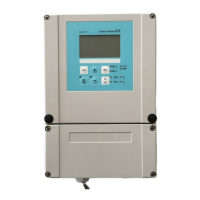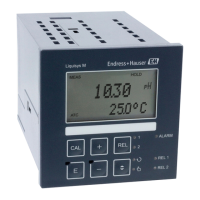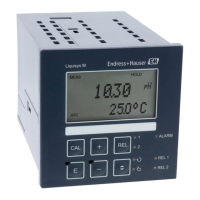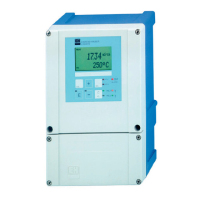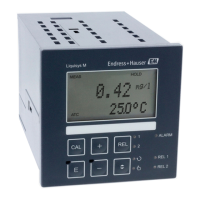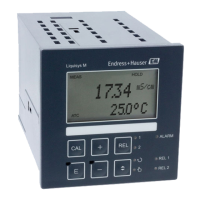Do you have a question about the Endress+Hauser Mycom CLM 152 and is the answer not in the manual?
| Manufacturer | Endress+Hauser |
|---|---|
| Product Name | Mycom CLM 152 |
| Category | Transmitter |
| Output signal | 4-20 mA |
| Communication | HART |
| Power supply | 10.5-45 V DC |
| Output Signals | 4-20 mA |
| Measuring principle | Conductivity |
| Accuracy | ±0.5% of reading |
| Operating Temperature | -20 to 60 °C |
| Housing Material | Stainless steel |
| Protection Class | IP67 |
Outlines the mandatory procedure for returning instruments, including obtaining authorization numbers and required information.
Explains safety-relevant symbols and conventions used throughout the operating manual for clear communication.
Confirms the instrument's development and manufacturing according to current European and U.S. standards and directives.
Describes the Mycom CLM 152's intended use as a microprocessor-controlled measuring and control instrument for conductivity analysis.
Provides essential warnings and guidelines for safe operation, installation, and maintenance to prevent hazards.
Details procedures for instrument repairs, emphasizing safe handling of potentially hazardous materials and proper disposal.
Lists the industries and sectors where the Mycom CLM 152 transmitter is suitable for measuring and control assignments.
Explains the fundamental principles behind the instrument's conductivity measurement, including toroidal and contacting methods.
Highlights the key functionalities and design aspects of the instrument, such as its display, operation, and modularity.
Details the various instrument versions available, including configuration and certificate options, power supply, and language.
Specifies requirements for packaging materials and ambient conditions to ensure optimal protection during storage and transport.
Provides instructions on how to physically install the instrument, including securing it using mounting holes.
Guides users through the proper electrical connections for the instrument, emphasizing safety precautions and correct wiring.
Details the specific wiring and connection procedures for both toroidal and contacting conductivity measuring cells.
Lists essential pre-checks and safety considerations before powering on the instrument for the first time.
Explains the initial guided setup process for configuring the instrument's basic settings upon first use.
Identifies and describes the physical controls of the instrument, including the display, LED status, and function keys.
Explains the information presented on the instrument's display screen and how to interpret it.
Details the specific actions and menu navigation provided by each key on the instrument's control panel.
Outlines the various formats and data points that can be displayed for measured values, including main and supplementary information.
Covers fundamental system settings like measurement type, cell connection, units, and sensor selection for optimal operation.
Details the configuration of current output signals, including characteristics, assignment, and hold functions for process control.
Explains how to configure temperature compensation settings, essential for accurate conductivity measurements in varying temperatures.
Details the settings related to instrument calibration, including hold duration and temperature entry for calibration solutions.
Details the configuration of limit monitoring functions for instruments equipped with two relay contacts.
Explains the configuration of limit monitoring for instruments featuring five relay contacts, allowing for more complex control.
Provides step-by-step instructions for calibrating the instrument when using toroidal measuring cells.
Details the procedures for calibrating the instrument when using contacting measuring cells, including cell constant determination.
Describes the FCYP module used for Profibus communication and its role in the measuring system.
Explains how to set the Profibus bus address for the instrument, a crucial step for network communication.
Details how to operate and configure the instrument remotely using the Commuwin II software via the Profibus interface.
Lists and describes the specific Profibus PA parameters for toroidal measurement, enabling detailed configuration and data access.
Provides a comprehensive list of error messages, their categories, and effects, aiding in troubleshooting instrument faults.
Describes how to access and interpret instrument information, including device details, software versions, and configuration.
Outlines various service functions available, such as simulation, internal data access, factory settings, and instrument checks.
Provides guidelines and recommendations for cleaning the instrument's housing and keys to maintain its performance and appearance.
Details the procedure for replacing fuses in the instrument, including safety precautions and the necessary fuse types.
Directs users to the appropriate channels for instrument repairs, emphasizing service by the manufacturer or authorized representatives.
Presents detailed technical specifications for the toroidal version of the instrument and its associated measuring cells.
Provides comprehensive technical specifications for the instrument when used with contacting electrodes.
Illustrates various wiring configurations and connection examples for toroidal measurements, demonstrating practical setups.
Shows detailed wiring diagrams and connection examples for instruments using contacting measuring cells in different applications.


